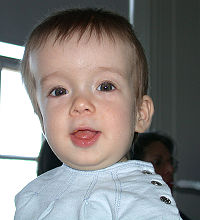
Photo from wikipedia
Objective The aim of this study was to identify quantitative tools to classify the severity of trigonocephaly to guide surgical management and predict outcome. Methods We reviewed high-resolution computed tomography… Click to show full abstract
Objective The aim of this study was to identify quantitative tools to classify the severity of trigonocephaly to guide surgical management and predict outcome. Methods We reviewed high-resolution computed tomography images of 59 patients with metopic synostosis. We assessed the craniofacial sutural pattern as well as interfrontal and metopic angles, and we related the frontal angulation degree with the sutural pattern, the surgical management, and clinical outcome. Results We identified 3 groups according to the severity of trigonocephaly. No difference was found between the sutural pattern of nasion complex and severity, whereas the closure of zygomatic maxillary sutures increased with the severity degree (P < 0.05). The operative management was related to the severity degree (P < 0.001) and to the reduced age (P = 0.009). Conclusions Interfrontal and metopic angles are complementary measurements to evaluate with high accuracy the degree of frontal angulation. In preoperative assessment, they may guide surgery decision in particular when the choice is not straightforward.
Journal Title: Journal of Computer Assisted Tomography
Year Published: 2020
Link to full text (if available)
Share on Social Media: Sign Up to like & get
recommendations!